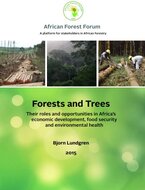In Africa, nearly all issues in the forestry debate of today revolve, directly or indirectly, around deforestation and forest degradation. Although current information as reported by FAO indicates a decrease in net forest loss in Africa, deforestation still remains a key
challenge in many countries. It is important to understand the broader context in which deforestation, forest and land degradation are taking place, and especially why they are so rapid in Africa as compared to other continents.
Understanding the changing role of forests and forestr requires a broader analysis of the state of society as defined by key features like production, consumption and the state of technology employed. Throughout the history of human civilisation, people have used
forests and trees for a variety of purposes economic, social, environmental, cultural and spiritual. This would imply that what is appropriate at a given point of time may cease to be so as circumstances change. As in the case of other regions, the society forest relationship (society/forestry nexus) in Africa also remains highly dynamic and there is a whole range of interventions resulting in multifarious outcomes with differing consequences on society and forests. Resource use priorities therefore differ considerably.
Broadly, societies can be grouped into four categories namely: forest dependent communities, agrarian societies, industrial societies and post-industrial societies. The principle uses of forests and the production and consumption characteristics of these societies differ considerably.Every country or region has differing proportions of people in each category. In general forestdependent and agrarian societies characterise most sub-Sahara African countries, while the proportion of industrial and post-industrial segment is low. This is in sharp contrast to most of the developed countries, where post-industrial and industrial societies dominate. Resource use priorities therefore differ considerably. Often some of the conflicts in resource use stem
from application of concepts and approaches to resource-use that are not seen as important from the perception of the dominant groups.
Due to the predominance of the agrarian society in most sub-Sahara African countries, the linkage between agriculture and forestry is rather strong, and what happens to forests is largely determined by what happens to agriculture. And as industrialisation progresses, forests have to cater to another array of needs; for example, to supply wood and non-wood products, as well as other ecosystem goods and services including carbon sequestration, biodiversity conservation, among others. On the other hand, the needs of a post-industrial society are somewhat different, with environmental and cultural aspects becoming more important. Depending on the proportion of societies in the different categories, the pressures and conflicts on the use of forests differ. A change in the proportion of different segments in society and changes in their perception of the use of forests will be most fundamental in determining the future of forests.
This booklet highlights developments in African forestry by these different societies. Also included are mechanisms that can enhance the roles of forests and trees in national eeconomic development and poverty alleviation, improve food security and nutrition, secure environmental stability and protect forest values on the continent. These are presented guided by the following themes: rehabilitation of degraded lands using trees; managing forests in the context of climate change; forest governance, marketing and trade in forest products; and socio-economic issues in forestry.
Godwin Kowero
Executive Secretary, African Forest Forum

